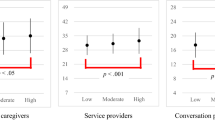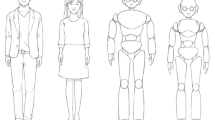Abstract
Considering the fact that gender stereotypes may influence people’s attitudes and feelings toward gendered robots, the present research conducted two questionnaire survey studies in Japan to investigate the relationships between expectations of gender assignments to robots and personal factors such as gender stereotypes and occupations. Study I aimed to clarify whether gender conceptions were actually related to feelings toward robots, as well as what factors affect these relationships. The results revealed that individuals with stronger gender biases had more negative attitudes in regard to the social influence of robots, and that correlations between negative attitudes toward interactions with robots and gender conceptions were age-dependent. Study II aimed to investigate what type of gender appearance was expected for nursing care robots. The results suggested that expectations of gender appearances were influenced by the participants’ gender and relationships between their occupations and nursing care, as was anxiety regarding the robots. These results suggest that research on gender in human–robot interaction may promote the future realization of gender equality.

Similar content being viewed by others
References
Alesich S, Rigby M (2017) Gendered Robots: implications for our Humanoid Future. IEEE Technol Soc Mag 36(2):50–59
Alexander E, Bank C, Jessica JJ, Hayes B, Scassellati B (2014) “Asking for help from a gendered robot,” In: Proceedings of the 36th Annual Conference of the Cognitive Science Society (CogSci2014). July 23–26, Quebec City, Quebec, Canada. Austin, TX: Cognitive Science Society; 2014: 2333–2338
Anthony LM, Clarke MC, Anderson SJ (2000) Technophobia and personality subtypes in a sample of south african university students. Comput Hum Behav 16:31–44
Bernotat J, Eyssel F, Sachse JS (2021) The (fe)male Robot: how Robot body shape Impacts First Impressions and Trust towards Robots. Int J Soc Robot 13(4):477–489
Chita-Tegmark M, Lohani M, Scheutz M (2019) Gender Effects in Perceptions of Robots and Humans with Varying Emotional Intelligence. In Proc. IEEE International Symposium on Human-Robot Interaction (HRI’19), 230–238
Cohen J (1988) Statistical power analysis for the behavioral sciences, 2nd edn. Lawrence Erlbaum, Hillsdale, NJ
Cohen J (1992) A power primer. Psychol Bull 112:155–159
De Angeli A, Brahnam S (2006) Sex Stereotypes and Conversational Agents. Ws. Gender and Interaction: Real and Virtual Women in a Male World 2006
Erebak S, Turgut T (2018) Negative Attitudes toward Robots Scale: Validity and Reliability of Turkish Version. Toros Üniversitesi İİSBF Sosyal Bilimler Dergisi, 5 (9), 407–418. Retrieved from https://dergipark.org.tr/en/pub/iisbf/issue/41627/486895
Eyssel F, Hegel F (2012) (S)he’s got the look: gender stereotyping of robots. J Appl Soc Psychol 42:2213–2230
Field A (2005) Discovering statistics using SPSS, 2nd edn. Sage Publications, London
Ito Y (1997) The formative factors of gender conception and its relationship with a selection of gender roles in adolescents. Japanese J Educational Psychol 45:396–404
Kraus M, Kraus J, Baumann M, Minker W (2018) Effects of Gender Stereotypes on Trust and Likability in Spoken Human-Robot Interaction. In: Proc. Eleventh International Conference on Language Resources and Evaluation (LREC 2018)
Kuchenbrandt D, Häring M, Eichberg J, Eyssel F (2012) Keep an Eye on the Task! How gender typicality of tasks influence human-robot interactions. In: Proceeding of the International Conference Social Robotics, 448–457
Ladwig RCE, Ferstl C (2018) What’s in a name? An Online Survey on Gender Stereotyping of Humanoid Social Robots. In Proc. 4th Conference on Gender & IT, pp.67–69
Marchetti-Bowick M (2009) Is your Roomba Male or Female? The role of gender stereotypes and cultural norms in Robot Design. Intersect: The Stanford Journal of Science Technology and Society 2(1):90–103
Mizumoto A, Takeuchi O (2008) Basics and Considerations for Reporting Effect Sizes. in Research Papers. Studies in English Language Teaching, 31: 57–66. (in Japanese)
NHK World-Japan (2018) Gender equality in Japan remains bottom”, Dec. 26, 2018. (https://www3.nhk.or.jp/nhkworld/en/news/backstories/335/)
Nomura T (2014) Comparison on Negative Attitude toward Robots and Related Factors between Japan and the UK. In Proc. 5th ACM International Conference on Collaboration Across Boundaries (CABS): Culture, Distance and Technology, pp.87–90
Nomura T (2017) Robots and gender. Gend Genome 1(1):18–25
Nomura T (2020) A possibility of inappropriate use of gender studies in human–robot Interaction. AI Soc 35:751–754
Nomura T, Kanda T, Suzuki T, Kato K (2008) Prediction of Human Behavior in Human-Robot Interaction using psychological scales for anxiety and negative Attitudes toward Robots. IEEE Trans Robot 24(2):442–451
Nomura T, Suzuki T (2022) Relationships between humans’ gender conception, expected gender appearances, and the Roles of Robots: a Survey in Japan. Int J Social Robot. https://doi.org/10.1007/s12369-022-00873-2
Nomura T, Suzuki T, Kanda T, Kato K (2006) Measurement of negative Attitudes toward Robots. Interact Stud 7(3):437–454
Nomura T, Suzuki T, Kanda T, Yamada S, Kato K (2011) Attitudes toward Robots and factors influencing them. In: Dautenhahn K, Saunders J (eds) New Frontiers in Human-Robot Interaction. John Benjamins Publishing, pp 73–88
Perugia G, Guidi S, Bicchi M, Parlangeli O (2022) The Shape of Our Bias: Perceived Age and Gender in the Humanoid Robots of the ABOT Database, In Proc. ACM/IEEE International Conference on Human-Robot Interaction, pp.110–119
Phillips E, Zhao X, Ullman D, Malle BF (2018) What is human-like? decomposing robots’ human-like appearance using the anthropomorphic robot (abot) database, in Proc. ACM/IEEE International Conference on Human-Robot Interaction, pp. 105–113
Pochwatko G, Giger J-C, Różańska-Walczu M, Świdrak J, Kukiełka K, Mozaryn J (2015) Polish Version of the negative attitude toward Robots Scale (NARS-PL). J Autom Mob Rob Intell Syst 9(3):65–72
Robertson J (2010) Gendering Humanoid Robots: Robo-Sexism in Japan. Body & Society 16:1–36
Siegel M, Breazeal C, Norton MI (2009) “Persuasive robotics: the influence of robot gender on human behavior,” In: Proceedings of the IEEE/RSJ international conference on intelligent robots and systems, 2009 IROS 2009. October 10–15, 2009. St. Louis, MO. Piscataway, NJ:: IEEE: 2563–2568
Tabachnick BG, Fidell LS (2006) Using multivariate statistics (5th international ed.). Boston, MA: Pearson/Allyn & Bacon
Tay B, Jung Y, Park T (2014) When stereotypes meet robots: the doubleedge sword of robot gender and personality in human-robot interaction. Comput Hum Behav 38:75–84
Weber J, Bath C (2007) Social’ Robots & ‘Emotional’ Software Agents: gendering processes and de-gendering strategies for ‘Technologies in the making. In: Zorn I, Maass S, Rommes E, Schirmer C, Schelhowe H (eds) Gender designs IT: construction and deconstruction of Information Society Technology. Springer, pp 53–63
Weiss A, Spiel K (2021) Should robots have a gender – Should they be gendered? Proc. RO-MAN 2021 Workshop on GENDERING ROBOTS: Ongoing (Re)configurations of Gender in Robotics, (2021). (https://sites.google.com/view/ro-man21-genr-workshop/proceedings)
Acknowledgements
This study was funded by Grants-in-Aid for Scientific Research (Nos. 20H05573 and 22H04870) from the Japan Society for the Promotion of Science.
Author information
Authors and Affiliations
Corresponding author
Ethics declarations
This study was funded by Grants-in-Aid for Scientific Research (Nos. 20H05573 and 22H04870) from the Japan Society for the Promotion of Science.
Conflict of interest
The authors declare that they have no conflicts of interest.
Additional information
Publisher’s Note
Springer Nature remains neutral with regard to jurisdictional claims in published maps and institutional affiliations.
Rights and permissions
Springer Nature or its licensor (e.g. a society or other partner) holds exclusive rights to this article under a publishing agreement with the author(s) or other rightsholder(s); author self-archiving of the accepted manuscript version of this article is solely governed by the terms of such publishing agreement and applicable law.
About this article
Cite this article
Nomura, T., Suzuki, T. Expectations of Robots’ Gender Appearances and Personal Factors: A Survey in Japan. Int J of Soc Robotics 15, 1903–1914 (2023). https://doi.org/10.1007/s12369-023-00984-4
Accepted:
Published:
Issue Date:
DOI: https://doi.org/10.1007/s12369-023-00984-4




